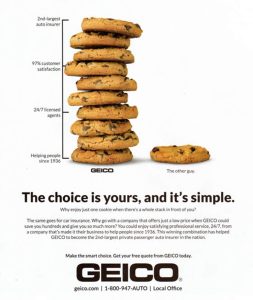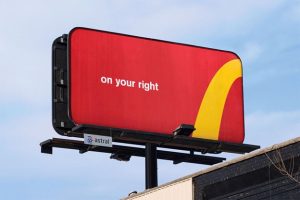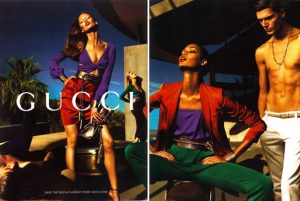12.4 Analyzing Advertisements: Descriptive Summary and Rhetorical Analysis
When we view a painting, it’s often because we’ve chosen to do so—usually by visiting a museum. Advertisements, on the other hand, enter our field of vision whether we want them to or not. In both print and digital media, advertisements swirl around us. They pop up on websites, appear in our social media feeds, fill the magazines we read, and interrupt the television shows that we watch. They’re everywhere, and because they’re such a routine part of the visual information we take in each day, it’s important to think critically about how these images are designed and for what purpose.
The Elements of Advertisements
We may not consider advertisements to be works of art, but they’re certainly created with an incredible attention to detail and to the viewer’s experience, just like the other examples of paintings and films discussed in this chapter. For that reason, you can use the same techniques for analyzing art work and movies when analyzing advertisements. For example, when analyzing a print advertisement like the one below, it would be important to observe the use of color, tone, perspective, movement, and how the various objects and individuals are arranged in relation to each other, among other elements.

Similarly, when analyzing a commercial, it would be important to observe not only the visual elements but the audio and narrative elements, as well. Commercials may not come close to the depth of character and plot development that films achieve, but they still tell us stories, often quite effectively. (Keep in mind that plenty of people watch the Super Bowl not for the football game but for the especially entertaining commercial breaks.)
The Rhetoric of Advertisements
The reason that ads are created with such care is because, like any image, they are designed to produce effects. Like a painting, they might lead us to reflect on our identity, our culture, or our values. Like a film, they might elicit our emotions or give us a unique narrative experience. Of course, we all know the primary effect that advertisers hope their advertisements will have. Advertisements are meant to persuade us: to spend money, to use products, and to support candidates or causes, among other possibilities. One could argue that all images are persuasive in one way or another, but advertisements are explicitly so. They want something from us, and they’re not shy about asking for it. Consider the example below.

Because advertisements are persuasive, you can analyze the rhetoric of an ad just like you can with any other text that’s trying to support a particular claim or point of view. Doing so will help you figure out why a particular advertisement was created and whether or not you want to accept its message. The chapter on “Writing Situations” in this textbook offers more information about how to analyze the rhetorical situation of a text. When thinking about advertisements, though, it’s especially important to ask yourself about:
- The Writer: Who created the ad? What mindset or point of view might this person, group, or organization bring to the subject matter of the ad?
- The Purpose: What is the ad meant to do? What effect is it supposed to have on the viewer?
- The Audience: Who are the targeted viewers of the ad? What mindset or point of view could these individuals have, and how could that affect how the ad is received?
- The Exigence: What motivated the creation of the ad in the first place? What perceived need or larger situation is the ad responding to?
To get some practice analyzing the rhetorical situation of an advertisement, study the sample ad below. What can you determine about its writer, purpose, audience, and exigence?

In addition to analyzing an advertisement’s rhetorical situation (who created it, for whom, and why) you can also analyze the rhetorical appeals that the ad uses in order to achieve its purpose. That is, what features of the ad make it persuasive? Again, you should refer to the chapter on “Writing Situations” in this textbook for more information about rhetorical appeals. A good place to begin, though, is to consider the use of ethos, pathos, and logos in an advertisement. You can consider:
- Ethos: How does the advertisement establish its credibility? Is there anything about the advertisement itself (its professionalism, its quality, its tone) that persuades viewers to accept its message? Is there anything about the creators or sponsors of the advertisement (their authority, their prestige) that persuades viewers to accept its message?
- Pathos: How does the advertisement speak to a viewer’s emotions? Does it try to make the viewer happy, angry, fearful, or distressed (among other possibilities) in order to affect the viewer’s judgment of the message?
- Logos: How does the advertisement use logical argument and support to communicate its message? Does it make reasonable claims? Are those claims supported with sound evidence?
To get some practice analyzing the rhetorical appeals of an advertisement, study the sample ad below. What can you determine about its use of ethos, pathos, and logos to persuade the viewer?

In many ways, analyzing the rhetoric of an advertisement is like analyzing the rhetoric of any text. It’s always important to think about the writer, purpose, audience, and exigence, as well as about rhetorical appeals like ethos, pathos, and logos. That said, there are special considerations to keep in mind when analyzing the rhetoric of an advertisement.
Advertisements are a genre quite unlike the other texts you’ll read and write about in College Composition, many of which are long-form academic essays. Advertisements are also different from the other visual genres discussed in this chapter, particularly when you think about how quickly ads are meant do their work. While we might spend an hour or more watching a film or several minutes contemplating a work of art, we usually just glance at a print advertisement or watch a few seconds of a commercial. In order to understand how an ad could possibly persuade a viewer in so short a time, we have to consider how they use features such as:
- Brief, catchy slogans or dialogue
- “Power words” that draw attention and elicit emotion (free, easy, exciting, delicious, etc.)
- Attention-grabbing fonts, images, and sounds
- Use of white space and color to quickly direct the viewer’s focus
- Foregrounding or repetition of key words, product names, or sponsors
- Use of name recognition or endorsement to establish authority
To get some practice analyzing how ads use these strategies, consider the sample ad below.

The Ideology of Advertisements
One of the most effective ways for an advertisement to persuade us is by appealing to our values and assumptions. We often support candidates and organizations whose ads support our own worldview, for instance. Similarly, we may purchase products because we believe our bodies, attitudes, and choices should resemble those of the models or spokespeople endorsing them. To fully understand how ads try to persuade us, it’s necessary to think about how they try to confirm our assumptions (or our fears) about ourselves, our culture, and our world.
Of course, even when the values and assumptions embedded in an advertisement are not part of a deliberate attempt to persuade us, it’s important to notice them and think critically about them. Advertisements are powerful. They’re everywhere. They can be flashy, provocative, and even fun. For these reasons, advertisements can normalize some beliefs (about race, for example, or body image or gender roles) and challenge or exclude others.
The critical theories already introduced in this chapter will help you to understand how the advertisements you analyze participate in our culture’s conversations about gender, race, class, and many other topics. You can find more information about these theories in this textbook’s chapter on “Literary Theory in the College Composition Classroom.”
An example of one scholar using critical theory (in this case, gender studies) to study advertisements is The Gender Ads Project by Scott A. Lukas. This site collects and analyzes advertisements in order to understand how they influence our ideas about gender and sexuality.
To practice thinking about how ads can reveal or even shape our assumptions about gender, consider the sample advertisement below.

Writing Exercise: Analyze an Advertisement
Use the strategies for visual analysis that you’ve learned about in this chapter to analyze the rhetoric of a print ad or commercial of your choice. Compose an analysis that:
- Describes the advertisement using the visual and narrative elements discussed in this chapter.
- Explains the advertisement’s rhetorical situation and use of rhetorical appeals.
- Explains how the advertisement reflects or challenges prominent cultural ideas about gender, race, class, sexuality, disability, or any of the other cultural issues discussed in this chapter.
Continue Reading: 12.5 Analyzing Public Art: Descriptive Summary and Rhetorical Analysis
